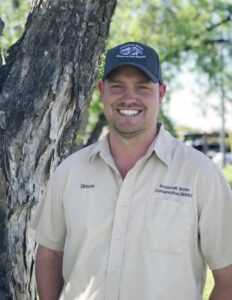The Roosevelt Water Conservation District (RWCD) has been serving local farmers, urban irrigators, and other central Arizona water users for almost a century. Located on the eastern edge of the Phoenix metro area in Maricopa County, its 40,000-acre service area overlaps with the quickly growing cities of Mesa and Chandler and the town of Gilbert, meaning that it is acquiring many new customers that have limited experience with and knowledge of irrigation. To communicate with and educate its new customers, RWCD has hired several new staff, including Simon Wallace, its neighborhood liaison supervisor, and Allison Brague, its public and media relations coordinator.
In this interview, Mr. Wallace and Ms. Brague join RWCD General Manager Shane M. Leonard to speak with Kris Polly, editor-in-chief of Irrigation Leader, about RWCD’s public outreach and how it has saved the district both time and money.

Kris Polly: Please tell us about how public outreach has helped RWCD save money.
Shane M. Leonard: About 3 years ago, I realized that our front office and a good portion of my administrative staff were increasingly being called away from their normally assigned duties by customer complaints. In addition, we realized that although we had folks in the field who were knowledgeable about delivering water, including zanjeros, lead zanjeros, and schedulers, we didn’t have anyone specifically dedicated to addressing customer issues and complaints. That issue has become more critical as an overall measure of success as our district urbanizes. When it was a primarily agricultural entity, RWCD had 400–500 users who typically knew what they were doing with their water and could solve most of their own problems. When we picked up 2,000 new customers in less than 7 years, we fell behind on customer service, and we have spent the next decade playing catch-up.
Roughly 5 years ago, I sat down with my staff to review a year’s worth of field reports. At that time, we were generating about 2,000 field reports a year. Everything RWCD does from an operational standpoint—water deliveries, system maintenance, etc.—is catalogued through a field report. If everything goes the way it’s supposed to, the field report is catalogued and goes into a searchable database. If a field report occurs when something anomalous happens—a low head call, a no head call, or even a car in the canal—the field report is directed up the chain of command to the appropriate level for resolution.
During this review, we ascribed a low, medium, or high level of importance to each field report and then assigned a time value to each outcome. We found that, particularly with medium- or high-importance field reports, as soon as the initial call came in, we were never going to get anywhere close to recapturing the stranded costs of resolving the issue over an appropriate timeline.

After reviewing the results of the study and talking with my staff, customers, and RWCD’s board of directors, I decided to set the goals of reducing the number of medium- and high-level customer-related field reports by 50 percent over the subsequent 3 years and reducing the total amount of staff time spent resolving them by 35 percent. The members of my board were supportive of these goals, but as the businessmen and businesswomen they are, they directed that these activities would have to be done within the confines of our existing budget.
I recognized the need to bring someone into the organization whose primary skill set did not focus on water operations, but on customer service. Almost immediately, I had someone in mind. There was a gentleman named Simon Wallace working at the gun shop I frequented whose customer service approach was always impressive.
A lot of interesting folks come into an Arizona gun shop, and I watched how he interacted with them and handled and deescalated situations, and more importantly, how he treated everyone with respect. Long story short, he agreed to come to work for the district before I even had a title for the position. I just knew we needed him, even though his experience with water was pretty much nil.
As I mentioned previously, one of our goals was to reduce the total amount of staff time (and the associated salary cost) spent resolving serious field reports by 35 percent over a 3-year period. With the addition of Simon to our team, and with a much more extensive involvement of our customers in resolving these issues, we not only achieved our desired goal within the first year, but we realized an approximately 65 percent reduction in the number of customer calls and an 80 percent reduction in the number of repetitive calls regarding the same problem. Instead of calling the office, these customers were calling Simon. Within the first year of implementation, the staff time and cost savings were not only paying for Simon’s position, but they reduced our overall salary line item budget by approximately 12 percent relative to the previous year’s overtime costs. Perhaps an even better result was that our customer satisfaction measures increased dramatically as well.
Seeing the results, the board’s somewhat reluctant approval of this plan turned into an open-armed embrace, so much so that it agreed that we needed more than one person in the position. We also started to realize that while Simon was doing an excellent job handling the infield issues, the district was still running up against a wall with our public outreach efforts, particularly on social media. For example, we had been trying to set up meetings in all of our irrigated neighborhoods to address local issues and to better inform our customers about RWCD, but after about a year, we realized we were not achieving our desired results. Some of the feedback we were getting from these meetings was that they were too technical; that we were not specifically addressing the neighborhood’s concerns; and most importantly, that almost no information about RWCD was available online. As others might suspect, water managers, attorneys, and engineers aren’t always the best people to present solutions to a relatively uninformed public.
Much as in the case of Simon, I began to focus on the efforts of a person I knew from outside my immediate professional sphere—in this case, someone I met volunteering in my kids’ school district. Allison Brague is a realtor by trade and a tireless advocate for the school district, and she knew how to use various social media platforms to engage the public on important issues. Like Simon, she knew very little about irrigation. Rather than being a hindrance, Allison’s relative inexperience helped us better understand how to best get information regarding RWCD to the public for the simple reason that she made us explain it to her in terms she could understand.
We now have two liaisons (and are in the process of hiring a third). With the addition of Allison, we have an entire department within RWCD devoted to addressing customer service. These positions were added without increasing our line item for salaries over the past 2 years.
Kris Polly: Simon, please tell us about your experience at RWCD.
Simon Wallace: I have been with RWCD for 21⁄2 years. When I first started coming to grips with the task at hand, I quickly discovered that there were several repeat callers who were consistently taking large amounts of the time of our zanjeros, lead zanjeros, schedulers, and office staff, either with phone calls or field visits. I collected all the information I could about why these people were calling, and while some had perfectly valid concerns and issues, it was less clear why others were contacting the district.
I began methodically working through these callers and either helping them solve their problems, redirecting their concerns

to the proper staff member, or helping them to understand that their issues were not necessarily the responsibility of the district. Many callers simply wanted to vent about repetitive neighborhood issues. Helping solve these issues, putting customers in contact with each other, or helping to mediate communications quickly reduced the number of these calls.
Next, I focused on the district’s new customers. Previously they were mostly left to figure things out for themselves, often by trial and error. By offering educational assistance early on, I could explain their responsibilities and the boundaries between RWCD-operated property and the neighborhood-owned, neighborhood-operated system. Meeting customers in their neighborhoods, walking their systems, making sure they knew what to do to get water to their properties, and setting them off on the right foot greatly reduced the number of calls and call-outs during their initial irrigation runs.
After that, I worked on reviewing individual customers’ situations whenever I got the chance. When responding to a low head call, a flood, or a neighborhood concern, I would often discover other issues that needed to be addressed. If I could help customers figure out these issues themselves, they would rely less heavily on the district. I took these opportunities to remind customers of their responsibilities, to share information learned about the neighborhood system, to advise them on maintenance, and to recommend internal neighborhood communication. This also reduced the number of concerns bought directly to RWCD.
Currently, I work mostly at the neighborhood level. I review neighborhood irrigation systems and the most common issues they experience. Via group email, I encourage the neighborhoods to consider the actions necessary to keep their systems up and running. Often, there are customers who are already spearheading much of their neighborhood’s system maintenance. I can assist these customers by sharing information on their behalf.
Kris Polly: What is the most common question you get from new customers?
Simon Wallace: The most common question I receive from new customers concerns ownership and responsibilities. There are a lot of misconceptions out there as to who owns and operates what. I clearly define the boundaries of RWCD-owned, RWCD-operated irrigation systems and those of the neighborhoods. A lot of confusion can be dispelled by explaining to the customers who owns and operates which systems and who is responsible for setting gates, directing water, cleaning ditches, and maintaining infrastructure. Once responsibilities are clearly outlined, I find that customers are much more willing to assume them.
Kris Polly: Do you reach out proactively to spread that information?
Simon Wallace: Yes. We communicate in person, via phone, by written notices sent by mail, by email, or at neighborhood sign-up box locations. We communicate at the individual customer level, the neighborhood level, and the district level.
The individual level is the most basic. We visit neighborhoods during their irrigation runs to make sure everything is running as intended, and we take the opportunity to stop and talk with any customers we can. This is a great way to learn and to share information. We encourage our customers to communicate among themselves; many these days are hesitant to do so. The results can be amazing. Sometimes the whole neighborhood comes together over an irrigation issue or system cleanup.
I send out group emails to neighborhood irrigation boards regarding current issues and maintenance. This not only increases general neighborhood awareness, but often it brings out those within the neighborhoods who are more socially inclined and willing to start up internal avenues of communication, whether via phone, e-mail, or social media. Such communication greatly increases a neighborhood’s levels of customer participation and makes it much more self-sufficient. On a district level, we are currently renovating our website. In the future, we want to be able to direct people there for any information they may require.
Kris Polly: Allison, please tell us about your work.

Allison Brague: I have been with the district for just about a year now. Like Shane said, I didn’t previously know much about irrigation, particularly on this scale. Although I’ve lived in the East Valley for 25 years, either within or close to the RWCD service area, I had no idea that its canals existed, and I didn’t know anything about flood irrigation. Learning about it has been interesting. That learning process has informed how I post on our social media accounts.
Our job on social media is to educate and provide value and eventually to drive everyone back to our website. Many of our customers only encounter RWCD when they first open an account, during a complaint, or when they look at their tax bill. My job is to show them what RWCD does, the value of that, and why it is worth it to know more about the district.
With social media, I can see what people like and what they don’t like. I was teasing my colleagues here at RWCD that if I post one more article about the drought contingency plan, I’m going to lose my entire viewership. While it is an important issue, many people don’t pay attention to it. Other things are shared more. I also listen to what Simon is hearing in the field, and what calls are coming into the front desk. That has provided a lot of content for me.
Our social media accounts are not yet where they need to be. For example, while we have about 2,300 customers who order water and pay their bills online, and about 500 more who come into the main office on a regular basis, we only have about 250 followers on Facebook. With that in mind, I am constantly refining what we are posting and how often we post to attract more of our existing customer base.
Our irrigated neighborhoods often have their own private social media groups. If I can get access to those groups and provide content for them, RWCD can reach and educate more people. People are interested in posts that are hyper-focused on seasonal information and events that are happening right now. Posts about what you should do when you encounter a rattlesnake or a coyote or how to deal with bees are popular this time of year. One of our most popular posts was about a lost dog that was rescued from one of our canals. The post about us assisting in rescuing the dog received 26,000 views and over 240 shares. Not only did we get more engagement on that post than we ever have on a direct irrigation post, the owner of the dog ended up getting it back because somebody had seen our post and shared it with her. That tells you that when we do post, people are watching. It shows how much reach we can have if the topic is important to our viewing public. If you want to view that post, you can see it on our Facebook page!
Kris Polly: I think that’s genius. You’re providing a real service to folks.
Allison Brague: Like a lot of other urbanizing districts, we have realized that we probably need a website that has a little more zest to it. Our new website is being built now. I sat in on a meeting with the web designer and our engineer—it helps to have someone like me who isn’t completely tech savvy to provide input on whether the website is user- friendly. In this day and age, people use their phones to access information, and they expect to find what they are looking for within a few clicks. If they can’t, they’re irritated.
Shane M. Leonard: With Allison and Simon’s input, we’re focusing on the mobile features first, and then backstopping them with the website.That’s what people want.

Kris Polly: What has been your experience delivering unwelcome news regarding rate increases?
Allison Brague: Oftentimes, management is afraid to talk about things like rate increases. Managers don’t know how customers are going to respond. Before we increased our rates, we sat down and had a meeting about how the increases would happen and what kind of pushback we might receive. We posted about our rate increases prior to their introduction, and we posted three more times after they went into effect. I think we had a total of two calls from people questioning them. I think that was surprising to management. The managers expected the increases to be more of a problem. In general, people just want to know about these things, and social media is good a way of informing them and avoiding unwelcome surprises. The construction of our new headquarters also threatened to be a touchy subject. We didn’t want to look like we were spending too much money on it, but we have been in our old location for 100 years and needed a new building. We posted around six times about our new headquarters, and we’ve only had one negative response. I think that as management sees that lack of a negative response, it is more confident in putting out real, transparent information about the district.
Shane M. Leonard: Very often I am asked for any words of caution regarding a public outreach program on this scale. As you increase public outreach, you need to do it in a managed, focused, and legal manner. There are things that might seem appropriate for public consumption that really are not, particularly as they relate to matters of privacy and potential litigation.That is why it is imperative you have an active, engaged, and trusted group of people involved in your outreach program.
Shane M. Leonard is general manager of the Roosevelt Water Conservation District. He can be contacted
at s.leonard@rwcd.net. Simon Wallace is RWCD’s neighborhood liaison supervisor. He can be contacted at s.wallace@rwcd.net. Allison Brague is RWCD’s public and media relations coordinator. She can be contacted at a.brague@rwcd.net. For more information about RWCD, please visit rwcd.net or call (480) 988-9586.
